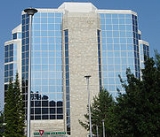
University of Saskatchewan Agriculture & Bioresources College
Encyclopedia
The College of Agriculture and Bioresources operates with an annual budget of $
38 million, from a variety of sources (2003/2004 data). There are approximately 1,000 students studying at the diploma, degree and postgraduate levels. There are 350 employees, including faculty, research scientists, administrative and scientific support staff.
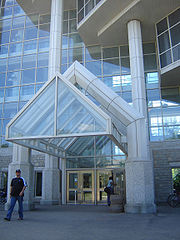 The Agriculture Building and contents represent an investment in excess of $100 million.
The Agriculture Building and contents represent an investment in excess of $100 million.
There are 18,000 square metres of usable space, consisting of 180 research labs, 38 teaching labs, 212 staff offices, 10 classrooms, 4 computer classrooms and 7 conference rooms.
There are 7 building levels, including an underground parkade and 3 building wings. There are also pedestrian walkways to Engineering (east), Anthropology (south), Biology (west) and Kirk Hall (south).
 The Agriculture Building and contents comprise 18,000 square metres of usable space, consisting of 180 research labs, 38 teaching labs, 212 staff offices, 10 classrooms, 4 computer classrooms and 7 conference rooms. There are 7 building levels, including an underground parkade and 3 building wings. There are also pedestrian walkways to Engineering (east), Anthropology (south), Biology (west) and Kirk Hall (south).
The Agriculture Building and contents comprise 18,000 square metres of usable space, consisting of 180 research labs, 38 teaching labs, 212 staff offices, 10 classrooms, 4 computer classrooms and 7 conference rooms. There are 7 building levels, including an underground parkade and 3 building wings. There are also pedestrian walkways to Engineering (east), Anthropology (south), Biology (west) and Kirk Hall (south).
Agriculture and Bioresources College held its first classes in the College Building
There were also 1000 acres (405 ha) reserved for agriculture practice, University Barn, crops, and livestock study. The new Agriculture building built between the years of 1988 and 1991 was a large 6 storey glass building, with a seventh floor addition in the year 2000.
The National Research Council contributed to the establishment of a Crop Development Centre at the University of Saskatchewan
Courses would be offered in the following fields Agricultural and Bioresource Engineering (ABE), Agricultural Economics (AGEC), Agriculture (AGRC), Agronomy (AGRN), Animal Science (ANSC), Environmental Science (EVSC), Food and Applied Microbiological Sciences (FAMS), Indigenous People Resource Management (IPRM), Large Animal Clinical Sciences (VLAC), Plant Sciences (PLSC), and Soil Science (SLSC).
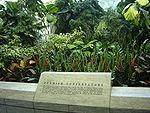 The Beamish Conservatory (Atrium) is named in honour of the donor May Beamish daughter of artist Augustus Kenderdine. The atrium is located in the College of Agriculture and Bioresources building.
The Beamish Conservatory (Atrium) is named in honour of the donor May Beamish daughter of artist Augustus Kenderdine. The atrium is located in the College of Agriculture and Bioresources building.
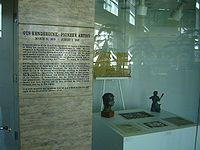 Kenderdine Art Gallery celebrated its official opening October 25, 1991. Augustus Frederick Lafosse (Gus) Kenderdine
Kenderdine Art Gallery celebrated its official opening October 25, 1991. Augustus Frederick Lafosse (Gus) Kenderdine
began the University Art Camp at Emma Lake in 1936, the precursor to the Emma Lake Kenderdine Campus, a bequest was donated to the University of Saskatchewan by his daughter, Mrs. May Beamish, and initialized the formation of the Kenderdine Art Gallery which has a permanent collection started by Dr. Murray, as well as ongoing exhibits.
The College of Agriculture and Bioresources operates with an annual budget of $
38 million, from a variety of sources (2003/2004 data). There are approximately 1,000 students studying at the diploma, degree and postgraduate levels. There are 350 employees, including faculty, research scientists, administrative and scientific support staff.
 The Agriculture Building and contents represent an investment in excess of $100 million.
The Agriculture Building and contents represent an investment in excess of $100 million.
There are 18,000 square metres of usable space, consisting of 180 research labs, 38 teaching labs, 212 staff offices, 10 classrooms, 4 computer classrooms and 7 conference rooms.
There are 7 building levels, including an underground parkade and 3 building wings. There are also pedestrian walkways to Engineering (east), Anthropology (south), Biology (west) and Kirk Hall (south).
 The Agriculture Building and contents comprise 18,000 square metres of usable space, consisting of 180 research labs, 38 teaching labs, 212 staff offices, 10 classrooms, 4 computer classrooms and 7 conference rooms. There are 7 building levels, including an underground parkade and 3 building wings. There are also pedestrian walkways to Engineering (east), Anthropology (south), Biology (west) and Kirk Hall (south).
The Agriculture Building and contents comprise 18,000 square metres of usable space, consisting of 180 research labs, 38 teaching labs, 212 staff offices, 10 classrooms, 4 computer classrooms and 7 conference rooms. There are 7 building levels, including an underground parkade and 3 building wings. There are also pedestrian walkways to Engineering (east), Anthropology (south), Biology (west) and Kirk Hall (south).
Agriculture and Bioresources College held its first classes in the College Building
There were also 1000 acres (405 ha) reserved for agriculture practice, University Barn, crops, and livestock study. The new Agriculture building built between the years of 1988 and 1991 was a large 6 storey glass building, with a seventh floor addition in the year 2000.
The National Research Council contributed to the establishment of a Crop Development Centre at the University of Saskatchewan
Courses would be offered in the following fields Agricultural and Bioresource Engineering (ABE), Agricultural Economics (AGEC), Agriculture (AGRC), Agronomy (AGRN), Animal Science (ANSC), Environmental Science (EVSC), Food and Applied Microbiological Sciences (FAMS), Indigenous People Resource Management (IPRM), Large Animal Clinical Sciences (VLAC), Plant Sciences (PLSC), and Soil Science (SLSC).
 The Beamish Conservatory (Atrium) is named in honour of the donor May Beamish daughter of artist Augustus Kenderdine. The atrium is located in the College of Agriculture and Bioresources building.
The Beamish Conservatory (Atrium) is named in honour of the donor May Beamish daughter of artist Augustus Kenderdine. The atrium is located in the College of Agriculture and Bioresources building.
 Kenderdine Art Gallery celebrated its official opening October 25, 1991. Augustus Frederick Lafosse (Gus) Kenderdine
Kenderdine Art Gallery celebrated its official opening October 25, 1991. Augustus Frederick Lafosse (Gus) Kenderdine
began the University Art Camp at Emma Lake in 1936, the precursor to the Emma Lake Kenderdine Campus, a bequest was donated to the University of Saskatchewan by his daughter, Mrs. May Beamish, and initialized the formation of the Kenderdine Art Gallery which has a permanent collection started by Dr. Murray, as well as ongoing exhibits.
The College of Agriculture and Bioresources operates with an annual budget of $
38 million, from a variety of sources (2003/2004 data). There are approximately 1,000 students studying at the diploma, degree and postgraduate levels. There are 350 employees, including faculty, research scientists, administrative and scientific support staff.
 The Agriculture Building and contents represent an investment in excess of $100 million.
The Agriculture Building and contents represent an investment in excess of $100 million.
There are 18,000 square metres of usable space, consisting of 180 research labs, 38 teaching labs, 212 staff offices, 10 classrooms, 4 computer classrooms and 7 conference rooms.
There are 7 building levels, including an underground parkade and 3 building wings. There are also pedestrian walkways to Engineering (east), Anthropology (south), Biology (west) and Kirk Hall (south).
 The Agriculture Building and contents comprise 18,000 square metres of usable space, consisting of 180 research labs, 38 teaching labs, 212 staff offices, 10 classrooms, 4 computer classrooms and 7 conference rooms. There are 7 building levels, including an underground parkade and 3 building wings. There are also pedestrian walkways to Engineering (east), Anthropology (south), Biology (west) and Kirk Hall (south).
The Agriculture Building and contents comprise 18,000 square metres of usable space, consisting of 180 research labs, 38 teaching labs, 212 staff offices, 10 classrooms, 4 computer classrooms and 7 conference rooms. There are 7 building levels, including an underground parkade and 3 building wings. There are also pedestrian walkways to Engineering (east), Anthropology (south), Biology (west) and Kirk Hall (south).
Agriculture and Bioresources College held its first classes in the College Building
There were also 1000 acres (405 ha) reserved for agriculture practice, University Barn, crops, and livestock study. The new Agriculture building built between the years of 1988 and 1991 was a large 6 storey glass building, with a seventh floor addition in the year 2000.
The National Research Council contributed to the establishment of a Crop Development Centre at the University of Saskatchewan
Courses would be offered in the following fields Agricultural and Bioresource Engineering (ABE), Agricultural Economics (AGEC), Agriculture (AGRC), Agronomy (AGRN), Animal Science (ANSC), Environmental Science (EVSC), Food and Applied Microbiological Sciences (FAMS), Indigenous People Resource Management (IPRM), Large Animal Clinical Sciences (VLAC), Plant Sciences (PLSC), and Soil Science (SLSC).
 The Beamish Conservatory (Atrium) is named in honour of the donor May Beamish daughter of artist Augustus Kenderdine. The atrium is located in the College of Agriculture and Bioresources building.
The Beamish Conservatory (Atrium) is named in honour of the donor May Beamish daughter of artist Augustus Kenderdine. The atrium is located in the College of Agriculture and Bioresources building.
 Kenderdine Art Gallery celebrated its official opening October 25, 1991. Augustus Frederick Lafosse (Gus) Kenderdine
Kenderdine Art Gallery celebrated its official opening October 25, 1991. Augustus Frederick Lafosse (Gus) Kenderdine
began the University Art Camp at Emma Lake in 1936, the precursor to the Emma Lake Kenderdine Campus, a bequest was donated to the University of Saskatchewan by his daughter, Mrs. May Beamish, and initialized the formation of the Kenderdine Art Gallery which has a permanent collection started by Dr. Murray, as well as ongoing exhibits.
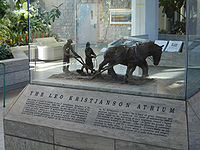
Canadian dollar
The Canadian dollar is the currency of Canada. As of 2007, the Canadian dollar is the 7th most traded currency in the world. It is abbreviated with the dollar sign $, or C$ to distinguish it from other dollar-denominated currencies...
38 million, from a variety of sources (2003/2004 data). There are approximately 1,000 students studying at the diploma, degree and postgraduate levels. There are 350 employees, including faculty, research scientists, administrative and scientific support staff.
History
The College of Agriculture and Bioresources was established at the at University of Saskatchewan in 1909. The change of the name of the college to College of Agriculture and Bioresources was approved by University Council in June 2005Buildings and Features

There are 18,000 square metres of usable space, consisting of 180 research labs, 38 teaching labs, 212 staff offices, 10 classrooms, 4 computer classrooms and 7 conference rooms.
There are 7 building levels, including an underground parkade and 3 building wings. There are also pedestrian walkways to Engineering (east), Anthropology (south), Biology (west) and Kirk Hall (south).

Agriculture and Bioresources College held its first classes in the College Building
College Building (Saskatchewan)
College Building is a National Historic Site of Canada which is part of the University of Saskatchewan . The U of S is the largest education institution in the Canadian province of Saskatchewan...
There were also 1000 acres (405 ha) reserved for agriculture practice, University Barn, crops, and livestock study. The new Agriculture building built between the years of 1988 and 1991 was a large 6 storey glass building, with a seventh floor addition in the year 2000.
The National Research Council contributed to the establishment of a Crop Development Centre at the University of Saskatchewan
Courses would be offered in the following fields Agricultural and Bioresource Engineering (ABE), Agricultural Economics (AGEC), Agriculture (AGRC), Agronomy (AGRN), Animal Science (ANSC), Environmental Science (EVSC), Food and Applied Microbiological Sciences (FAMS), Indigenous People Resource Management (IPRM), Large Animal Clinical Sciences (VLAC), Plant Sciences (PLSC), and Soil Science (SLSC).
Vision
The College's vision is for a high and sustainable quality of life supported throughout the nation by the responsible utilization, conservation and management of the world's natural resources.Programs
The Agriculture & Bioresources College programs at the University of Saskatchewan include:- Diploma in Agriculture with Specialization in Agribusiness; Diploma in Agriculture with Specialization in Agronomy; Diploma in Agriculture with Specialization in Animal Science; Diploma in Agriculture with Specialization in General Agriculture
- Bachelor of Science in AgricultureBachelor of Science in AgricultureThe Bachelor of Science in Agriculture, usually abbreviated as either B.Sc. or B.S.A. or BScAg, is the first undergraduate degree awarded by university faculty of agriculture and agricultural colleges. The program is 4 years of study above Grade 12 High School graduation.The B.Sc. degree differs...
; Bachelor of Agriculture in Animal Science; Bachelor of Agriculture in Biotechnology; Bachelor of Agriculture in Crop Science; Bachelor of Agriculture in Environmental Science; Bachelor of Agriculture in Food Science; Bachelor of Agriculture in Horticultural Science; Bachelor of Agriculture in Plant Sciences; Bachelor of Agriculture in Soil Science; Bachelor of Agriculture in Rangeland Resources - Master of Agriculture in Agricultural Economics; Master of Agriculture in Animal and Poultry Science; Master of Agriculture in Applied Microbiology; Master of Agriculture in Biotechnology; Master of Agriculture in Food Science; Master of Agriculture in Plant Science; Master of Agriculture in Soil Science.
Beamish Conservatory

This conservatory is named to honour Mrs. May Beamish, who with her husband, Oswald, farmed near Lashburn, SaskatchewanLashburn, Saskatchewan-Demographics:-External links:...
. Mrs. Beamish was a great inspiration in planning this building. Her enerous financial contributions enabled the University to include both the Kenderdine Gallery, a home for her father's artwork, and the Beamish Conservatory. Together, these two facilities will help sturdents, staff and visitors to better appreciate the beauty of the Saskatchewan environment, its ecology and its great productive potential.
Kenderdine Art Gallery

Augustus Kenderdine
Augustus Frederick Lafosse Kenderdine was a landscape and portrait artist of Lancashire and Saskatchewan, a farmer of Saskatchewan, and academic at the University of Saskatchewan.-England:...
began the University Art Camp at Emma Lake in 1936, the precursor to the Emma Lake Kenderdine Campus, a bequest was donated to the University of Saskatchewan by his daughter, Mrs. May Beamish, and initialized the formation of the Kenderdine Art Gallery which has a permanent collection started by Dr. Murray, as well as ongoing exhibits.
The College of Agriculture and Bioresources operates with an annual budget of $
Canadian dollar
The Canadian dollar is the currency of Canada. As of 2007, the Canadian dollar is the 7th most traded currency in the world. It is abbreviated with the dollar sign $, or C$ to distinguish it from other dollar-denominated currencies...
38 million, from a variety of sources (2003/2004 data). There are approximately 1,000 students studying at the diploma, degree and postgraduate levels. There are 350 employees, including faculty, research scientists, administrative and scientific support staff.
History
The College of Agriculture and Bioresources was established at the at University of Saskatchewan in 1909. The change of the name of the college to College of Agriculture and Bioresources was approved by University Council in June 2005Buildings and Features

There are 18,000 square metres of usable space, consisting of 180 research labs, 38 teaching labs, 212 staff offices, 10 classrooms, 4 computer classrooms and 7 conference rooms.
There are 7 building levels, including an underground parkade and 3 building wings. There are also pedestrian walkways to Engineering (east), Anthropology (south), Biology (west) and Kirk Hall (south).

Agriculture and Bioresources College held its first classes in the College Building
College Building (Saskatchewan)
College Building is a National Historic Site of Canada which is part of the University of Saskatchewan . The U of S is the largest education institution in the Canadian province of Saskatchewan...
There were also 1000 acres (405 ha) reserved for agriculture practice, University Barn, crops, and livestock study. The new Agriculture building built between the years of 1988 and 1991 was a large 6 storey glass building, with a seventh floor addition in the year 2000.
The National Research Council contributed to the establishment of a Crop Development Centre at the University of Saskatchewan
Courses would be offered in the following fields Agricultural and Bioresource Engineering (ABE), Agricultural Economics (AGEC), Agriculture (AGRC), Agronomy (AGRN), Animal Science (ANSC), Environmental Science (EVSC), Food and Applied Microbiological Sciences (FAMS), Indigenous People Resource Management (IPRM), Large Animal Clinical Sciences (VLAC), Plant Sciences (PLSC), and Soil Science (SLSC).
Vision
The College's vision is for a high and sustainable quality of life supported throughout the nation by the responsible utilization, conservation and management of the world's natural resources.Programs
The Agriculture & Bioresources College programs at the University of Saskatchewan include:- Diploma in Agriculture with Specialization in Agribusiness; Diploma in Agriculture with Specialization in Agronomy; Diploma in Agriculture with Specialization in Animal Science; Diploma in Agriculture with Specialization in General Agriculture
- Bachelor of Science in AgricultureBachelor of Science in AgricultureThe Bachelor of Science in Agriculture, usually abbreviated as either B.Sc. or B.S.A. or BScAg, is the first undergraduate degree awarded by university faculty of agriculture and agricultural colleges. The program is 4 years of study above Grade 12 High School graduation.The B.Sc. degree differs...
; Bachelor of Agriculture in Animal Science; Bachelor of Agriculture in Biotechnology; Bachelor of Agriculture in Crop Science; Bachelor of Agriculture in Environmental Science; Bachelor of Agriculture in Food Science; Bachelor of Agriculture in Horticultural Science; Bachelor of Agriculture in Plant Sciences; Bachelor of Agriculture in Soil Science; Bachelor of Agriculture in Rangeland Resources - Master of Agriculture in Agricultural Economics; Master of Agriculture in Animal and Poultry Science; Master of Agriculture in Applied Microbiology; Master of Agriculture in Biotechnology; Master of Agriculture in Food Science; Master of Agriculture in Plant Science; Master of Agriculture in Soil Science.
Beamish Conservatory

This conservatory is named to honour Mrs. May Beamish, who with her husband, Oswald, farmed near Lashburn, SaskatchewanLashburn, Saskatchewan-Demographics:-External links:...
. Mrs. Beamish was a great inspiration in planning this building. Her enerous financial contributions enabled the University to include both the Kenderdine Gallery, a home for her father's artwork, and the Beamish Conservatory. Together, these two facilities will help sturdents, staff and visitors to better appreciate the beauty of the Saskatchewan environment, its ecology and its great productive potential.
Kenderdine Art Gallery

Augustus Kenderdine
Augustus Frederick Lafosse Kenderdine was a landscape and portrait artist of Lancashire and Saskatchewan, a farmer of Saskatchewan, and academic at the University of Saskatchewan.-England:...
began the University Art Camp at Emma Lake in 1936, the precursor to the Emma Lake Kenderdine Campus, a bequest was donated to the University of Saskatchewan by his daughter, Mrs. May Beamish, and initialized the formation of the Kenderdine Art Gallery which has a permanent collection started by Dr. Murray, as well as ongoing exhibits.
The College of Agriculture and Bioresources operates with an annual budget of $
Canadian dollar
The Canadian dollar is the currency of Canada. As of 2007, the Canadian dollar is the 7th most traded currency in the world. It is abbreviated with the dollar sign $, or C$ to distinguish it from other dollar-denominated currencies...
38 million, from a variety of sources (2003/2004 data). There are approximately 1,000 students studying at the diploma, degree and postgraduate levels. There are 350 employees, including faculty, research scientists, administrative and scientific support staff.
History
The College of Agriculture and Bioresources was established at the at University of Saskatchewan in 1909. The change of the name of the college to College of Agriculture and Bioresources was approved by University Council in June 2005Buildings and Features

There are 18,000 square metres of usable space, consisting of 180 research labs, 38 teaching labs, 212 staff offices, 10 classrooms, 4 computer classrooms and 7 conference rooms.
There are 7 building levels, including an underground parkade and 3 building wings. There are also pedestrian walkways to Engineering (east), Anthropology (south), Biology (west) and Kirk Hall (south).

Agriculture and Bioresources College held its first classes in the College Building
College Building (Saskatchewan)
College Building is a National Historic Site of Canada which is part of the University of Saskatchewan . The U of S is the largest education institution in the Canadian province of Saskatchewan...
There were also 1000 acres (405 ha) reserved for agriculture practice, University Barn, crops, and livestock study. The new Agriculture building built between the years of 1988 and 1991 was a large 6 storey glass building, with a seventh floor addition in the year 2000.
The National Research Council contributed to the establishment of a Crop Development Centre at the University of Saskatchewan
Courses would be offered in the following fields Agricultural and Bioresource Engineering (ABE), Agricultural Economics (AGEC), Agriculture (AGRC), Agronomy (AGRN), Animal Science (ANSC), Environmental Science (EVSC), Food and Applied Microbiological Sciences (FAMS), Indigenous People Resource Management (IPRM), Large Animal Clinical Sciences (VLAC), Plant Sciences (PLSC), and Soil Science (SLSC).
Vision
The College's vision is for a high and sustainable quality of life supported throughout the nation by the responsible utilization, conservation and management of the world's natural resources.Programs
The Agriculture & Bioresources College programs at the University of Saskatchewan include:- Diploma in Agriculture with Specialization in Agribusiness; Diploma in Agriculture with Specialization in Agronomy; Diploma in Agriculture with Specialization in Animal Science; Diploma in Agriculture with Specialization in General Agriculture
- Bachelor of Science in AgricultureBachelor of Science in AgricultureThe Bachelor of Science in Agriculture, usually abbreviated as either B.Sc. or B.S.A. or BScAg, is the first undergraduate degree awarded by university faculty of agriculture and agricultural colleges. The program is 4 years of study above Grade 12 High School graduation.The B.Sc. degree differs...
; Bachelor of Agriculture in Animal Science; Bachelor of Agriculture in Biotechnology; Bachelor of Agriculture in Crop Science; Bachelor of Agriculture in Environmental Science; Bachelor of Agriculture in Food Science; Bachelor of Agriculture in Horticultural Science; Bachelor of Agriculture in Plant Sciences; Bachelor of Agriculture in Soil Science; Bachelor of Agriculture in Rangeland Resources - Master of Agriculture in Agricultural Economics; Master of Agriculture in Animal and Poultry Science; Master of Agriculture in Applied Microbiology; Master of Agriculture in Biotechnology; Master of Agriculture in Food Science; Master of Agriculture in Plant Science; Master of Agriculture in Soil Science.
Beamish Conservatory

This conservatory is named to honour Mrs. May Beamish, who with her husband, Oswald, farmed near Lashburn, SaskatchewanLashburn, Saskatchewan-Demographics:-External links:...
. Mrs. Beamish was a great inspiration in planning this building. Her enerous financial contributions enabled the University to include both the Kenderdine Gallery, a home for her father's artwork, and the Beamish Conservatory. Together, these two facilities will help sturdents, staff and visitors to better appreciate the beauty of the Saskatchewan environment, its ecology and its great productive potential.
Kenderdine Art Gallery

Augustus Kenderdine
Augustus Frederick Lafosse Kenderdine was a landscape and portrait artist of Lancashire and Saskatchewan, a farmer of Saskatchewan, and academic at the University of Saskatchewan.-England:...
began the University Art Camp at Emma Lake in 1936, the precursor to the Emma Lake Kenderdine Campus, a bequest was donated to the University of Saskatchewan by his daughter, Mrs. May Beamish, and initialized the formation of the Kenderdine Art Gallery which has a permanent collection started by Dr. Murray, as well as ongoing exhibits.
Gus Kenderdine:Pioneer Artist
March 31, 1870 to August 3, 1947
It was the stories of the Barr colonists which led Augustus Kenderdine to bring his family to Lashburn, SaskatchewanLashburn, Saskatchewan-Demographics:-External links:...
in 1908. Already recognized in England and on the Continent for his abilities as a landscape and portrait artist, Gus Kenderdine had planned to stay only the three years needed to prove up the homestead. But he loved this land with its vast expanses, its ever-changing sky and glorious sunsets, and, in particular, its northern lakes and forests. He stayed for a lifetime.
Gus Kenderdine was a true visionary. He became the first Professor of Art and Head of the Department of Art at the University of Saskatchewan, teaching in both ReginaRegina, SaskatchewanRegina is the capital city of the Canadian province of Saskatchewan. The city is the second-largest in the province and a cultural and commercial centre for southern Saskatchewan. It is governed by Regina City Council. Regina is the cathedral city of the Roman Catholic and Romanian Orthodox...
and SaskatoonSaskatoonSaskatoon is a city in central Saskatchewan, Canada, on the South Saskatchewan River. Residents of the city of Saskatoon are called Saskatonians. The city is surrounded by the Rural Municipality of Corman Park No. 344....
. Not only did he continue to share his joy in the natural world through painting, he dreamed of giving others the opportunity to develop their skill in that setting. The Murray Point Art School, now known as the Kenderdine Campus of the University of Saskatchewan, was the result of his dedication and perseverance. Hundreds of artists from across North America and beyond have been inspired, and, in turn, enriched the lives of others through sharing in this legacy.
It is with humility and gratitude that we pay tribute to the life and work of Gus Kenderdine, pioneer artist.
Kloppenburg Collection
The Kloppenburg Collection is featured on the 6th floor of the College of Agriculture and Bioresources building which opened in 1991. 27 works by famous Saskatchewan artists are featured in this donation to the University of Saskatchewan. The art forming the Kloppenburg College of the College of Agriculture and Bioresources was donated by Henry R Kloppenburg QC, a Saskatchewan Rhodes Scholar, and Cheryl L Kloppenburg. They are well known art collectors and patrons of the arts in Saskatchewan. They are practicing lawyers in Saskatoon, Saskatchewan with a longtime interest in the arts and agriculture.Leo Kristjanson Atrium

This atrium is named in honour of Leo F. Krisjanson, President of the University of Saskatchewan, 1980-1989, who brought the dream of an agricultural sciences complex to fruition. He saw the goal of establishing a Canadian and world centre of agricultural excellence for teaching, research and public service as a continuation of the spirit and determination of Saskatchewan's first pioneers, who endured against many challenges in establishing prairie agriculture. He was convinced that this pioneering spirit could be extended to all aspects of the University's endeavours. In Dr. Kristjanson's words: "In a land of great distances and physical hardship, co-operation, the sense of community, and a mutual regard for the well-being of one's neighbour, created a legacy that enabled its people to write large - to build far greater than circumstances seemed to warrant. Like the pioneers of yesterday, we must continue to plan for a better future - a future where we can continue to write large; a future where co-operation and respect for the dignity of the individual allows all to make their contribution."
Agricultural Displays
The agricultural wall displays are located in the walkway connecting the Agriculture Building and the Biology Building.See also
- Canadian Agriculture Safety AssociationCanadian Agriculture Safety AssociationThe Canadian Agricultural Safety Association was established in 1993 in response to an identified need for a national farm safety networking and coordinating agency to address problems of illness, injuries and accidental death in farmers, their families and agricultural workers...
- College Building (Saskatchewan)College Building (Saskatchewan)College Building is a National Historic Site of Canada which is part of the University of Saskatchewan . The U of S is the largest education institution in the Canadian province of Saskatchewan...
national historic site Canada - University of SaskatchewanUniversity of SaskatchewanThe University of Saskatchewan is a Canadian public research university, founded in 1907, and located on the east side of the South Saskatchewan River in Saskatoon, Saskatchewan, Canada. An "Act to establish and incorporate a University for the Province of Saskatchewan" was passed by the...
- University of Saskatchewan AcademicsUniversity of Saskatchewan AcademicsUniversity of Saskatchewan has over 200 academic programs on its Saskatoon, Saskatchewan campus, and is internationally known for its teaching and research. The on-campus synchrotron Canadian Light Source makes it the only Canadian institution for such nuclear and biotechnology research...
- List of agricultural universities and colleges

